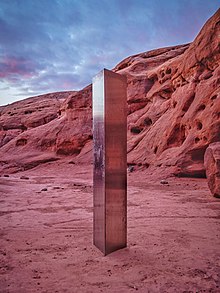| Utah monolith | |
|---|---|
 The monolith at its original location | |
 Location where the monolith was found | |
| Artist | Unknown |
| Year | 2016 |
| Type | Metal sculpture |
| Medium | stainless steel or aluminum (assumed) |
| Dimensions | 291 cm × 50.6 cm × 58 cm (114.5 in × 19.92 in × 23.0 in)[1] |
| Condition | disassembled but later reassembled |
| Location | formerly Lockhart Basin in San Juan County, Utah, United States; 27 km (17 mi) southwest of Moab, currently held at undisclosed location by the Bureau of Land Management |
| 38°20′35.1″N 109°39′58.3″W / 38.343083°N 109.666194°W | |
The Utah monolith was a metal pillar that stood in a red sandstone slot canyon in northern San Juan County, Utah, United States. The pillar was 3 m (9.8 ft) tall and made of metal sheets riveted into a triangular prism. It was unlawfully placed on public land between July and October 2016; it stood unnoticed for over four years until its discovery and removal in late 2020. The identity of its makers is unknown, as are their objectives.
Utah state biologists discovered the monolith in November 2020 during a helicopter survey of wild bighorn sheep. Within days of its discovery, members of the public found the pillar using GPS mapping software and made their way to the remote location. Following intense media coverage, it was covertly removed on November 27, 2020, by four residents of Moab, Utah. After nearly a month in their possession, the monolith was given to the Bureau of Land Management and is currently in their custody.[2][3][4]
Following the discovery of the monolith, over two hundred similar metal columns were erected in other places throughout the world, including elsewhere in North America and countries in Europe, South America and Australia.[5][6] Many were built by local artists as deliberate imitations of the Utah monolith.[7]
- ^ Richards, Jeff (November 25, 2020). "Mystery of metal monolith at least partly solved as sleuths figure out its location". Saint George News. Archived from the original on December 16, 2020. Retrieved November 27, 2020.
- ^ Kovaleski, Serge F.; Solomon, Deborah; Rosenberg, Zoe (December 1, 2020). "Earthlings, It Seems, Not Aliens, Removed the Utah Monolith – A photographer said four men dismantled the mysterious shiny object that has captivated the country. – Updated 12/02/2020". The New York Times. Archived from the original on December 16, 2020. Retrieved December 2, 2020.
- ^ "Artist or aliens? Mystery surrounds Utah monolith's appearance and disappearance". NBC News. November 30, 2020. Archived from the original on December 16, 2020. Retrieved December 1, 2020.
- ^ Brown, Meaghen (December 23, 2020). "The Saga of the Monolith Isn't Over Yet". Outside Online. Retrieved December 26, 2020.
- ^ "Monolith Tracker". Monolith Tracker. November 18, 2020. Archived from the original on March 14, 2023. Retrieved January 2, 2021.
- ^ Taub, Matthew (December 16, 2020). "Trying to Make Sense of the Mystery Monolith Craze of 2020". Atlas Obscura. Retrieved December 18, 2020.